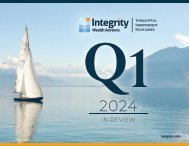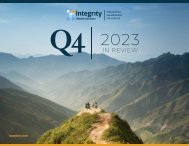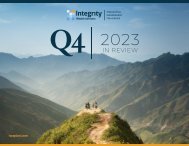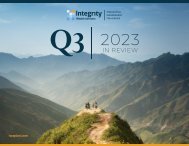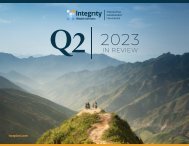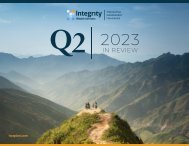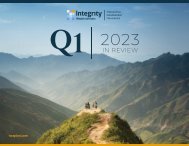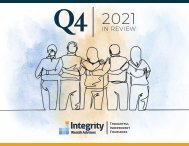You also want an ePaper? Increase the reach of your titles
YUMPU automatically turns print PDFs into web optimized ePapers that Google loves.
<strong>Q2</strong><br />
<strong>2022</strong><br />
IN REVIEW
TOTAL RETURN <strong>2022</strong> <strong>Q2</strong> + NEWSWORTHY EVENTS<br />
April 7 – Global food prices<br />
increase to their highest<br />
level since the UN's Food<br />
Price <strong>In</strong>dex began in 1990<br />
April 25 – Social media<br />
network Twitter accepts a<br />
buyout offer from Elon Musk<br />
for $44 billion USD<br />
April 28 – The U.S.<br />
economy shrank<br />
0.30% in the first<br />
quarter of <strong>2022</strong><br />
May 6 – U.S. Department of Labor reported<br />
strong growth with 428,000 positions added<br />
by employers, and the unemployment rate held<br />
steady at 3.6%<br />
May 20 – The World Health<br />
Organization (WHO) holds<br />
an emergency meeting<br />
to discuss the spread of<br />
monkeypox in nearly a dozen<br />
countries, as the number of<br />
reported cases reaches 100<br />
June 10 – U.S. inflation<br />
hit 8.6% in May<br />
June 13 – S&P 500 <strong>In</strong>dex<br />
closed in “bear market”<br />
territory for the first time<br />
since March 2020<br />
June 15 – U.S. Federal Reserve<br />
raised its benchmark interest<br />
rate by 75 basis points, marking<br />
its biggest rate hike in 28 years<br />
June 23 – Applications for<br />
jobless aid fell to 229,000, a<br />
decline from the previous week<br />
2%<br />
S&P 500 TOTAL RETURN<br />
MSCI ACWI EX USA TOTAL RETURN<br />
BARCLAYS US AGGREGATE TOTAL RETURN<br />
0%<br />
-2%<br />
-4%<br />
-4.69%<br />
-6%<br />
-8%<br />
-10%<br />
-12%<br />
-14%<br />
-16%<br />
-16.1%<br />
-13.5%<br />
-18%<br />
-20%<br />
April<br />
May<br />
June<br />
As of close 6/30/<strong>2022</strong><br />
12%<br />
S&P 500 TOTAL RETURN<br />
MSCI ACWI EX USA TOTAL RETURN<br />
BARCLAYS US AGGREGATE TOTAL RETURN<br />
Source: https://en.wikipedia.org/wiki/<strong>2022</strong><br />
11%<br />
10.42%
ARE WE ON THE EVE OF A RECESSION?<br />
<strong>2022</strong><br />
<strong>Q2</strong><br />
IN REVIEW<br />
Real GDP declined at a 1.5% annual rate in the first quarter and, as of<br />
7/06/<strong>2022</strong>, the Atlanta Fed’s “GDP Now” model projects negative growth in <strong>Q2</strong>.<br />
If you take the Atlanta GDP Now model at face value, it appears that we will<br />
have two consecutive quarters of negative growth, although we will not know<br />
for sure until late July. This is important, because two consecutive quarters<br />
of negative growth is a rule of thumb that many people use as a marker for a<br />
recession.<br />
Recessions in the US are officially declared by a committee of eight<br />
economists at the National Bureau of Economic Research (NBER). This<br />
committee weighs jobs, manufacturing, and real incomes when assessing<br />
whether we are in a recession, not just real GDP. <strong>In</strong> the first five months of the<br />
year, manufacturing production was up at a 6.6% annual rate, non-farm payrolls<br />
were up at an average monthly pace of 488,000, and the unemployment rate<br />
dropped from 3.9% to 3.6%. Meanwhile, in April, both “real” (inflation-adjusted)<br />
consumer spending and real personal income (excluding transfers) were at<br />
record highs. <strong>In</strong> addition, real gross domestic income (real GDI), an alternative<br />
measure of economic output, rose at a 2.1% annual rate in the first quarter.<br />
Even with this solid economic data, we do expect a recession to come in<br />
the next 24 months, mainly due to the Federal Reserve raising interest rates<br />
aggressively to fight inflation back down toward the 2.0% target. However,<br />
we do not foresee a recession like the one in 2008-09. Bank capital is well<br />
above regulatory requirements. We do not have a mark-to-market accounting<br />
rule that will generate a “fire sale” in bank assets, nor are we about to have a<br />
government lockdown of the private sector, as was the case in 2020.<br />
When it comes, the recession will cause economic pain for many - recessions<br />
always do. But we expect something like the recessions in 1990-91 or 2001,<br />
when the unemployment rate went up between 2.0 and 2.5 percentage points<br />
(Bloomberg Economic Data), not a repetition of the soaring unemployment we<br />
saw during the Great Recession or the 2020 Lockdown.<br />
ECONOMIC CHARTS & NOTES<br />
CONSUMER SENTIMENT Consumer sentiment fell to an all-time low as 47%<br />
of consumers blamed inflation for eroding their living standards. Retail sales<br />
declined unexpectedly in May as Americans reduced spending at both stores and<br />
online.<br />
EMPLOYMENT Companies continued to hire in Q1, especially those in the<br />
leisure, hospitality, and professional services industries. Unemployment held<br />
steady, and slightly above the lowest level since 1969, confirming a strong<br />
jobs market.<br />
US Retail Sales<br />
Consumer Sentiment<br />
Unemployment Rate<br />
NonFarm Payroll<br />
34%<br />
100<br />
16%<br />
2200<br />
US Retail Sales % Chg<br />
28%<br />
22%<br />
16%<br />
10%<br />
4%<br />
-2%<br />
-8%<br />
95<br />
90<br />
85<br />
80<br />
75<br />
70<br />
65<br />
Consumer Sentiment<br />
Unemployment Rate %<br />
14%<br />
12%<br />
10%<br />
8%<br />
6%<br />
4%<br />
-825<br />
-3850<br />
-6875<br />
-9900<br />
-12925<br />
-15950<br />
-18975<br />
NonFarm Payroll<br />
-14%<br />
Jan '19<br />
Jul '19<br />
Jan '20<br />
Jul '20<br />
Jan '21<br />
Jul '21<br />
Jan '22<br />
60<br />
2%<br />
Jan ' 19<br />
Jul '19<br />
Jan '20<br />
Jul '20<br />
Jan '21<br />
Jul '21<br />
Jan '22<br />
-22000<br />
Source: University of Michigan Consumer Sentiment. Retail Sales - U.S. Census Bureau.<br />
Source: U.S. Bureau of Labor Statistics
ECONOMIC CHARTS & NOTES<br />
CONSUMER PRICE INDEX <strong>In</strong>flation climbed to its highest level since<br />
1981, as fuel prices doubled year-over-year. Core inflation (ex. gas and food<br />
prices) rose more than expected, led by increased housing costs.<br />
Amount in Thousands Y/Y % Chg<br />
8%<br />
7%<br />
6%<br />
5%<br />
4%<br />
3%<br />
2%<br />
1%<br />
0%<br />
Jan ' 18<br />
JOB OPENINGS & HIRES Retail hiring slowed amid a shift in consumer<br />
spending from goods to services, but retail job gains remained well above prepandemic<br />
levels. Companies like Target and Walmart faced inventory challenges<br />
and disappointing earnings.<br />
1500<br />
1200<br />
900<br />
600<br />
300<br />
0<br />
Jan '18<br />
Jul '18<br />
CPI Less Food<br />
Jul '18 Jan ' 19<br />
Jan '19<br />
Jul '19<br />
Retail Hires<br />
Jul '19<br />
Jan '20<br />
Jan '20<br />
Jul '20<br />
Jul '20<br />
Retail Openings<br />
Jan '21<br />
CPI All<br />
Jan '21<br />
Source: U.S. Bureau of Labor Statistics<br />
Source: U.S. Bureau of Labor Statistics<br />
Jul '21<br />
Jul '21 Jan '22<br />
Jan '22<br />
CONSUMER SPENDING Disposable income declined slightly, as did<br />
inflation-adjusted spending. A rising cost of living absorbed increased spending<br />
power from job and wage gains.<br />
% Chg Year-over-year<br />
GDP Real GDP adjusted for inflation contracted 1.6% despite the addition of 1.6<br />
million jobs in Q1. If the Fed’s forecast for -1% GDP growth in <strong>Q2</strong> holds, it would<br />
signify a mild recession.<br />
% Growth<br />
30<br />
25<br />
20<br />
15<br />
10<br />
5<br />
0<br />
-5<br />
-10<br />
-15<br />
-20<br />
-25<br />
Jan '19<br />
35%<br />
30%<br />
25%<br />
20%<br />
15%<br />
10%<br />
5%<br />
0%<br />
-5%<br />
-10%<br />
-15%<br />
-20%<br />
-25%<br />
-30%<br />
-35%<br />
Jul '19<br />
2017<br />
Consumption<br />
Jan '20<br />
Jul ' 20<br />
Jan '21<br />
GDP<br />
Disposable <strong>In</strong>come<br />
Jul '21<br />
Source: U.S. Bureau of Economic Analysis<br />
Jan '22<br />
Q1 <strong>Q2</strong> Q3 Q4 Q1 <strong>Q2</strong> Q3 Q4 Q1 <strong>Q2</strong> Q3 Q4 Q1 <strong>Q2</strong> Q3 Q4 Q1 <strong>Q2</strong> Q3 Q4<br />
2018 2019 2020 2021<br />
Source: U.S. Bureau of Economic Analysis<br />
Q1<br />
<strong>2022</strong>
OPPORTUNITIES ABROAD<br />
<strong>2022</strong><br />
<strong>Q2</strong><br />
IN REVIEW<br />
Despite rising inflation, the People’s Bank of China<br />
(PBOC) decided to keep a key one year medium<br />
term interest rate unchanged at 2.85%. PBOC cut<br />
this interest rate earlier this year to help economic<br />
conditions. PBOC actions seem to indicate that<br />
inflation in the Asian nation is not as bad as<br />
across other emerging markets, and is in line with<br />
their actions to continue to stimulate the Chinese<br />
economy. Historically, people will consume more<br />
because their buying power is not impacted by the<br />
rising cost of credit.<br />
China is one of two countries that lowered interest<br />
rates this year (Russia being the other), while most<br />
other countries around the world have raised rates to<br />
fight inflation, or have left rates unchanged. Further,<br />
China is now considering allowing local governments<br />
to sell up to $220 billion in bonds, which are aimed at<br />
infrastructure improvement that would significantly<br />
boost the Chinese economy. Both of these current<br />
economic events are unique tailwinds for Chinese<br />
companies, and we feel this creates a great<br />
investment opportunity.<br />
China's nominal GDP reached $17.5 trillion in 2021,<br />
which is a growth rate of 8.1% over last year. However,<br />
we do expect a slower GDP growth rate in <strong>2022</strong>, due<br />
to very tight Covid measures in the second quarter of<br />
this year.<br />
China is becoming more willing to accept single-digit<br />
Covid cases, as is evidenced by the reopening of<br />
schools and restaurants. The Chinese government<br />
announced the decision to shorten the isolation<br />
period for positive Covid cases, and also adjust the<br />
frequency of Covid tests according to the risk factors<br />
for infection. This is a much more flexible policy than<br />
it was in early June <strong>2022</strong>.<br />
During the worst period of lockdowns, the (negative)<br />
contribution of the consumer market to the economy<br />
was obvious from statistics and chart data.<br />
Structurally, these changes in statistics lead one<br />
to believe the Chinese economy has transformed<br />
into one that is more diversified, with a big<br />
consumer market, and with more capital-intensive<br />
manufacturing activities. It seems logical that<br />
consumer demand should return as Covid rules are<br />
relaxed. Thus, it is expected that retail sales will turn<br />
from negative year-on-year growth in 2<strong>Q2</strong>2, to positive<br />
year-on-year growth in 2H22. Another positive effect<br />
from this change is that foreign exporters should also<br />
benefit from the recovery of the Chinese consumer<br />
market.<br />
With the Chinese consumer market undergoing<br />
a recovery, infrastructure investments are a key<br />
economic support factor, especially after the<br />
contraction of most economic activities in 2<strong>Q2</strong>2.<br />
We expect an infrastructure investment equivalent<br />
to around 5% of GDP for <strong>2022</strong>. These infrastructure<br />
investments would be mostly funded by local<br />
government special bonds, local government financial<br />
vehicles, central government funds, and loans from<br />
policy banks in China.<br />
External demand has been<br />
robust. Couple this with<br />
Chinese port congestion<br />
easing, and this should<br />
yield a better international<br />
trade environment.<br />
Further, in a recent meeting<br />
between U.S. Defence<br />
Chief Lloyd Austin and<br />
Chinese Defence Minister<br />
Wei Fenghe, clear lines<br />
of communication were<br />
defined while respecting<br />
one another’s internal<br />
affairs. The respective<br />
government representatives also discussed instability<br />
in the Taiwan Strait, with the U.S. making its support<br />
of Taiwan clear. This U.S. policy approach will surely<br />
impact the market, fostering a feeling of security for<br />
global investors.<br />
The U.S. is also considering removing some of the<br />
tariffs on goods imported from China that were<br />
imposed by the Trump administration. There will not<br />
likely be a removal of tariffs on technology-related<br />
products produced by China, however, and this factor<br />
will remain a drag on Chinese technology companies.<br />
The U.S./Chinese technology war will be a long-term<br />
issue for economic growth, given that China does not<br />
have the technology to manufacture equipment for<br />
the most advanced semiconductors, as the U.S. and<br />
its allies have prevented China from gaining access<br />
to this advanced technology. <strong>In</strong> turn, China is trying to<br />
get talent from the rest of the world, hoping to create<br />
its own advanced technologies. This will likely prove<br />
to be a most challenging mission for the Chinese<br />
semiconductor industry.<br />
Source: China’s Economic Outlook For H2 <strong>2022</strong> | Seeking Alpha Gold Has Been One of the Few Bright Spots in <strong>2022</strong> (So Far) (usfunds.com)
ANNUAL<br />
RETURNS AND<br />
INTRA-YEAR<br />
DECLINES<br />
As can be seen in the accompanying chart, despite<br />
average intra-year drops of 14% from 1980 until <strong>2022</strong>,<br />
annual returns were positive in 32 of the 42 years.<br />
This emphasizes the need to stay calm and ride out<br />
volatile markets. Even better would be to invest more<br />
at market lows! See the Financial Planning section of<br />
this review for an article on how to take advantage of<br />
volatility though Dollar Cost Averaging.<br />
S&P INTRA-YEAR DECLINES VS. CALENDAR YEAR RETURNS<br />
40%<br />
34%<br />
31%<br />
30%<br />
29%<br />
26% 27% 26% 27%<br />
26%<br />
26%<br />
27%<br />
23%<br />
20%<br />
15% 17% 20%<br />
19%<br />
20%<br />
16%<br />
15%<br />
12%<br />
14% 13% 13%<br />
11%<br />
4% 7% 9%<br />
10%<br />
YTD<br />
1% 2%<br />
3% 4%<br />
0%<br />
-6% -2%<br />
0%<br />
-3%<br />
-6% -1%<br />
-7%<br />
-3%<br />
-7%-6% -5%<br />
-5%<br />
-7% -8% -8% -8% -9% -8% -12%<br />
-8%<br />
-7% -6%<br />
-10%<br />
-9%<br />
-8%<br />
-<br />
-10%<br />
-17%<br />
-11%<br />
-10%<br />
-10%<br />
-13%<br />
-13%<br />
-12% -11% 7%<br />
-14%<br />
-20%<br />
-16%<br />
-17%-18%<br />
-17%<br />
-21%<br />
-20%<br />
-19%<br />
-19%<br />
-20%<br />
-23%<br />
-24%<br />
-28%<br />
-30%<br />
-34%<br />
-34%<br />
-34%<br />
-40%<br />
-38%<br />
-49%<br />
-60%<br />
'80 '85 '90 '95 '00 '05 '10 '15 '20<br />
Sources: FactSet, Standard & Poor's, J.P. Morgan Asset Management. Returns are based on price index only and do not include dividends. <strong>In</strong>tra-year drops refers to the largest market drops from a peak to a trough during the year.<br />
For illustrative purposes only. Returns shown are calendar year returns from 1980 to 2021, over which time period the average annual return was 9.4%. Data as of June 30.<strong>2022</strong><br />
A MARKET CORRECTION CAN BE AN OPPORTUNITY<br />
THREE REACTIONS TO A MARKET DOWNTURN<br />
Hypothetical $10,000 <strong>In</strong>ititial <strong>In</strong>vestments, <strong>In</strong>dex 2007-2021<br />
Hypothetical $10,000 <strong>In</strong>itial <strong>In</strong>vestments<br />
<strong>In</strong>dex 2007–2021<br />
Sold out of stocks at market low Held stocks through market downturn Added $10,000 at market low<br />
Sources: Thompson Financial, Lipper and Bloomberg. Chart represents a hypothetical $10,000 investment in the S&P 500 <strong>In</strong>dex from October 9, 2007 through December 31, 2021 with the conditions described in the text.<br />
Hypotheticals assume a cash yeild of 1.0% per year. <strong>In</strong>vestments cannot be made in an index. Past performance is no guarantee of future events.
BOND OUTLOOK IMPROVING<br />
<strong>2022</strong><br />
<strong>Q2</strong><br />
IN REVIEW<br />
Recent moves in economic data, monetary policy, and financial markets have<br />
involved magnitudes not seen in decades. Last month inflation, as gauged by<br />
the Consumer Price <strong>In</strong>dex (CPI), hit a 40-year high of 8.6%. The Federal Reserve<br />
responded with its biggest interest rate hike since 1994. According to Freddie<br />
Mac, the average 30-year mortgage rate rose to the highest level since 2008, on<br />
the biggest weekly climb since 1987. Major equity indexes have fallen into bear<br />
markets, down more than 20% from recent peaks, while bonds have suffered by<br />
far the worst start to any year on record.<br />
<strong>In</strong>vestors are keenly aware of the losses that have been inflicted on even the most<br />
diversified portfolios, and there’s no guarantee that an end is in sight. But there<br />
are signs that, as in past steep market declines, the current losses are resetting<br />
valuations to levels that can prove attractive to investors who stay focused on the<br />
long term, with potential diversification benefits also improving. Based on recent<br />
indications of where the economy may be heading, we believe the investment<br />
outlook has become more constructive, particularly for bonds.<br />
<strong>In</strong> 1994, the last time the Fed raised rates by 75 bps at once, it was fighting<br />
concerns about inflation that never fully materialized. Then, the Fed began its<br />
hiking cycle slowly and accelerated, with bond yields peaking before the final hike.<br />
This time, the Fed is hiking more aggressively early on, raising the possibility that<br />
yields may peak well before the Fed reaches its ultimate policy-rate target. There<br />
are relatively defensive areas of fixed income markets that are now offering more<br />
attractive yields than we have seen in some time. That has helped to increase<br />
both potential income and the margin for error for investors.<br />
Recent months have been cause for anxiety in all corners of financial markets,<br />
with many cross-currents for investors to figure out, including persistent inflation<br />
and geopolitical tensions. Uncertainties linger over when market momentum<br />
might eventually turn. Over the long history of financial markets, there have been<br />
routs that have been similarly painful to the one investors are experiencing this<br />
year. As has happened in the past, these declines can help reset asset valuations<br />
and set the stage for better days ahead.<br />
Financial assets and the economy are getting squeezed<br />
as the Fed tightens financial conditions in its intensifying<br />
quest to quell inflation. As a result, the likelihood of<br />
a recession appears to be rising. As of June 16th,<br />
the Federal Reserve Bank of Atlanta’s GDP Now tool<br />
estimates that the U.S. economy will show negative<br />
growth in the second quarter of <strong>2022</strong>. Bonds tend to<br />
perform well during recessionary periods, and if the Fed<br />
succeeds in bringing inflation lower, it could create an<br />
even stronger backdrop for fixed-income investments.<br />
One of the best gauges of forward returns for bonds is<br />
the starting yield. The 10-year U.S. Treasury yield has<br />
risen from about 1.63% to about 3.25% since the start of<br />
<strong>2022</strong>. This surge in yields has inflicted unprecedented<br />
price losses on existing bonds, but it has also created a<br />
better starting point for new investments in terms of both<br />
potential income and diversification attributes – two of<br />
the bedrock reasons for owning bonds.<br />
Source: After Historic Market Moves, Outlook for Bonds Improves | PIMCO
SUPPLY CHAIN & INFLATION<br />
SPENDING ROTATING BACK TO SERVICES<br />
Goods share in total U.S. consumer spending, 2000-<strong>2022</strong><br />
CONSUMER SPENDING ROTATING<br />
Consumers significantly changed their spending throughout the pandemic – spending more on<br />
goods and less on services. <strong>In</strong> fact, in less than 18 months, the preceding 18 years of decline in the<br />
share of goods in consumer spending reversed (see chart). One of the signs of the post-pandemic<br />
economy getting back to normal logically would be spending switching back towards services. Is it<br />
possible U.S. data last week suggests this has begun (see the recent tick back down in the chart)?<br />
Only time will tell.<br />
What significance does this have on investors? That spending shift has been a key driver of<br />
inflation. The surge in demand for goods created bottlenecks and supply shortages, which in turn<br />
pushed up prices. As demand normalizes again, those supply issues should ease and inflationary<br />
pressure should start to subside. There is a risk that consumer spending – on both goods and<br />
services – could come to a standstill. With the Fed increasing policy rates, the cost of finance is<br />
rising rapidly in the U.S. That typically deals a blow to economic growth. These are the subject<br />
questions surrounding the outcome of future consumer spending in the U.S. and Europe. There are<br />
further consumption and supply insights from data in the manufacturing sector. What does that<br />
data show?<br />
MANUFACTURERS SLOW PRODUCTION<br />
Manufacturers have slowed production substantially in both the U.S. and Euro areas,<br />
according to survey data released last week (see chart). Why? First, they have a build-up of<br />
existing stock that they have not yet been able to sell. Secondly, fears exist about how strong<br />
demand for goods will be in coming months. This reflects a broader slowdown happening<br />
across both economies; services growth is slowing, too. Several factors are behind the<br />
outlook changes. Europe is feeling the energy shock exacerbated by the war in Ukraine more<br />
acutely. High energy prices are eating away at disposable income and consumer confidence<br />
is falling. Another factor for the U.S. is the rapidly rising cost of finance, due to the Fed’s<br />
decision to go hard on inflation. That typically weakens economic growth.<br />
If there is one positive sign for manufacturers, it is that supplier delivery times have<br />
shortened, potentially indicating pandemic-related production constraints are resolving. The<br />
risk? It may also be a sign of falling demand, rather than easing supply. This chart shows<br />
slowing U.S. and Euro area output surveys. We are keeping a close eye on these metrics to<br />
determine how to navigate these changes to macro landscape, and ultimately on allocation<br />
decisions for portfolio investments.<br />
Source: Top chart; BlackRock <strong>In</strong>vestment <strong>In</strong>stitute and U.S. Bureau of Economic Analysis, with data from Haver Analytics, July <strong>2022</strong>. Chart shows U.S. goods spending as ashare of total consumer spending. Bottom chart<br />
shows the PMI surveys of manufacturing output for the U.S. and euro area. The survey is expressed as the balance of firms reporting an increase in output on the month minus those reporting a decrease, so a reading of<br />
over 50 implies that overall output increased in the month. Markit, with data from Haver Analytics, June <strong>2022</strong>. July 5th Weekly Commentary from www.blackrock.com
RESIDENTIAL REAL ESTATE<br />
Residential real estate<br />
<strong>2022</strong><br />
<strong>Q2</strong><br />
IN REVIEW<br />
The residential housing market continues to be tough for buyers, with inventories still at record lows coupled with record high prices and mortgage rates doubling<br />
this year. Even still, mortgage rates are below 40-year averages and credit scores of mortgage originations are extremely strong. We do not believe that the data<br />
supports a housing market crash like we saw in the Great Recession of ’08.<br />
( GTM u.s.@<br />
Average interest rate on a U.S. mortgage<br />
30-year fixed-rate mortgage<br />
18%<br />
16%<br />
14%<br />
12%<br />
10%<br />
8%<br />
6%<br />
4%<br />
2%<br />
Jun. <strong>2022</strong>: 5.5%<br />
0%<br />
'82 '85 '88 '91 '94 '97 '00 '03 '06 '09 '12 '15 '18 '21<br />
Home prices<br />
y/y % change in Case-Shiller Home Price <strong>In</strong>dex<br />
25%<br />
20%<br />
15%<br />
10%<br />
5%<br />
0%<br />
-5%<br />
-10%<br />
Apr. <strong>2022</strong>: 20.4%<br />
-15%<br />
'88 '91 '94 '97 '00 '03 '06 '09 '12 '15 '18 '21<br />
Housing inventories<br />
lm.entory of new and existing single family homes for sale, thous, NSA<br />
4,500<br />
4,000<br />
3,500<br />
3,000<br />
2,500<br />
2,000<br />
1,500<br />
1,000<br />
500<br />
'82 '85 '88 '91 '94 '97 '00 '03 '06 '09 '12 '15 '18 '21<br />
Mortgage originations by credit score*<br />
Billions of USD<br />
1,400<br />
1,200<br />
1,000<br />
800<br />
600<br />
400<br />
200<br />
■
RECESSION RISK BY COMPARISON<br />
U.S. RECESSION RISK INDICATORS<br />
FINANCIAL ECONOMIC<br />
CONFIDENCE<br />
Housing Permits<br />
Job Sentiment<br />
Jobless Claims<br />
Retail Sales<br />
Wage Growth<br />
Commodities<br />
ISM New Orders<br />
Profit Margins<br />
Truck Shipments<br />
Credit Spreads<br />
Money Supply<br />
Yield Curve<br />
Overall Signal<br />
CURRENT 2020 2007-09 2001 1990-91 1981-82 1980 1973-75 1969-70<br />
N/A<br />
N/A<br />
U.S. ECONOMIC OUTLOOK<br />
• U.S. recession risks are well below average despite<br />
current GDP forecasts<br />
• Our preferred version of the yield curve (10Y-3M) has<br />
steepened recently indicating continued economic<br />
expansion<br />
• Consumer Headwinds < Consumer Tailwinds<br />
U.S. MARKET OUTLOOK<br />
• U.S. markets have often experienced choppiness as<br />
the economy and accommodative policy transition<br />
from early to mid-cycle<br />
• Current headwinds include tightening monetary policy,<br />
midterm elections, negative fiscal impulse, geopolitics,<br />
and high inflation<br />
• <strong>In</strong> our view, any selloff would be a good opportunity to<br />
reposition for the middle innings of this market cycle<br />
RECESSION DASHBOARD<br />
OVERALL SIGNAL<br />
EXPANSION<br />
Expansion Caution Recession<br />
Data as of June 15, <strong>2022</strong>. Source: FactSet, Bloomberg, Conference Board, Census Bureau, Federal Reserve, FRBPA, Chicago Fed, ISM, Dept. of Labor, Bloomberg/Barclays, AAII, <strong>In</strong>vestors <strong>In</strong>telligence, and Moody’s.
HAS YOUR BUSINESS FILED FOR THE ERC CREDIT?<br />
<strong>2022</strong><br />
<strong>Q2</strong><br />
IN REVIEW<br />
The ERC (Employee Retention Credit) is a one-time Federal refundable tax credit that came to life under the CARES Act. The tax credit was designed to<br />
encourage employers to keep employees on their payroll. <strong>In</strong> December of 2020, the ERC was modified by the Taxpayer Certainty and Disaster Tax Relief Act,<br />
expanding its scope to all organizations that received Paycheck Protection Program (PPP) loans, as well as organizations that did not receive any PPP loans.<br />
This constitutes a majority of both small businesses and non-profits in the country. This modification created an opportunity for most small businesses and<br />
organizations with fewer than 500 employees to claim this tax credit.<br />
IS MY BUSINESS ELIGIBLE FOR THE EMPLOYEE RETENTION CREDIT?<br />
While eligibility per state can be nuanced based on state-by-state shutdown policies and mandates, most businesses in every state in America are eligible if they<br />
meet ONE of the three following criteria:<br />
THE EMPLOYER<br />
EXPERIENCES A<br />
SIGNIFICANT DECLINE IN<br />
GROSS RECEIPTS<br />
OR<br />
THE EMPLOYER’S BUSINESS<br />
OPERATIONS ARE FULLY OR<br />
PARTIALLY SUSPENDED DUE TO<br />
A GOVERNMENTAL ORDER<br />
OR<br />
YOUR BUSINESS<br />
SAW A NOMINAL<br />
SUPPLY CHAIN<br />
DISRUPTION<br />
HOW MUCH COULD THE CREDIT BE?<br />
From the baseline, the tax credit equates to 50% of a qualified employee’s wages, up to a maximum credit of $5,000 per employee in 2020 (against the first<br />
$10,000 in employee wages), and a maximum credit of $21,000 per employee in 2021. Qualified employee’s wages are those that were not funded with monies<br />
from the Paycheck Protection Program (PPP). Restaurants, bars, and other qualified employers that paid employees during tax years 2020 or 2021 with non-PPP<br />
monies can potentially see refund checks amounting from tens of thousands of dollars to hundreds of thousands of dollars, if not more. The credit can be as<br />
high as $26,000 per employee for 2020 and 2021 combined.<br />
CLAIM YOUR ERC IN FOUR EASY STEPS<br />
1. Confirm your business is eligible for the ERC.<br />
2. Gather pertinent payroll data, PPP loan documentation, and other information.<br />
3. Calculate credit amount and prepare amended tax return(s).<br />
4. Claim your credit with the IRS and get paid.<br />
CONTACT US TO LEARN MORE.<br />
We will be happy to speak with you and address<br />
any additional questions or concerns you may<br />
have about the ERC.<br />
<strong>In</strong>tegrity <strong>Wealth</strong> <strong>Advisors</strong> are not registered tax preparers.
INVESTMENT<br />
MANAGEMENT<br />
PHILOSOPHY<br />
The complex, ever-changing investment world of today<br />
requires an investment process that is overseen by a team<br />
of experienced investment professionals. Global capital<br />
markets present investors with a host of challenges due to<br />
the combination of an overwhelming amount of information<br />
to analyze and the endless supply of conflicting opinions and<br />
narratives surrounding financial markets. The time and expertise<br />
required to perform in-depth investment research and to make<br />
timely and informed portfolio management decisions requires<br />
both a clear investment process and an experienced investment<br />
team to implement the process.<br />
An old adage states that there is accomplishment through<br />
many advisors. We agree and embrace a variety of investment<br />
perspectives through our investment committee. Our investment<br />
philosophy is well grounded in global macro-economic analysis.<br />
<strong>In</strong>vestment ideas are carefully vetted through a process which<br />
incorporates the diverse range of investment backgrounds<br />
within our firm. This process of multifaceted analysis ensures<br />
that only the strongest investment ideas survive. We are<br />
committed to striking the right balance between risk and<br />
return through managing global, multi-asset class investment<br />
portfolios.<br />
INDEPENDENCE &<br />
CLIENT FOCUS<br />
DIVERSIFICATION<br />
TOP-DOWN, THEMATIC<br />
APPROACH<br />
PERFORMANCE WITH<br />
LIQUIDITY<br />
VARIED INVESTMENT<br />
PERSPECTIVES<br />
OPTIMIZATION OF<br />
EXPENSES AND TAXES<br />
THE INVESTMENT PROCESS<br />
ASSESSMENT OF GLOBAL<br />
ECONOMIC & INVESTMENT<br />
ENVIRONMENT<br />
ASSESS & ANALYZE<br />
THEMES<br />
RESEARCH INVESTMENT<br />
VEHICLES TO FIND<br />
EFFECTIVE IMPLEMENTATION<br />
IDENTIFY<br />
OPPORTUNITIES<br />
STRATEGIC ASSET<br />
ALLOCATION -<br />
Geographies, Sectors,<br />
Capitalizations<br />
INVESTMENT SELECTION -<br />
Open/Closed End Funds, ETFs, Stocks & Bonds
INVESTMENT COMMITTEE<br />
<strong>2022</strong><br />
<strong>Q2</strong><br />
IN REVIEW<br />
The <strong>In</strong>vestment Committee meets formally<br />
each quarter, and more frequently if market<br />
conditions warrant, to discuss the state of<br />
the global economy and capital markets and<br />
to assess the current asset allocation and<br />
positioning of our portfolios. There’s an art<br />
to striking the right balance between risk and<br />
return; pursuing that symmetry is the core of<br />
our investment philosophy. We are fiduciaries<br />
and have our interests aligned with our<br />
clients, as we invest alongside them.Contact<br />
us at investmentcommittee@iwaplan.com<br />
with any questions or concerns.<br />
STEPHEN WAGNER<br />
CEO, <strong>In</strong>vestment Advisor,<br />
CFP ® , CPFA<br />
35+ Years Experience*<br />
VICTORIA BREEN<br />
<strong>In</strong>vestment Advisor &<br />
Financial Planner<br />
40+ Years Experience*<br />
MARTHA LAFF<br />
<strong>In</strong>vestment Advisor,<br />
ChFC ® , CLU ® , CRPC ®<br />
30+ Years Experience*<br />
ANDREW MURTHA<br />
Financial Analyst,<br />
MBA<br />
20+ Years Experience*<br />
BOB CHEATHAM<br />
Financial Planner,<br />
CRPS®, MA<br />
MARGARET MARAPAO<br />
<strong>In</strong>vestment Advisor &<br />
Financial Planner, CFP ®<br />
CHRISTOPHER WAGNER<br />
<strong>In</strong>vestment Advisor &<br />
Financial Planner, CPFA<br />
LAINE MILLER<br />
<strong>In</strong>vestment Advisor &<br />
Financial Planner, CFP ®<br />
DOUG ECKER<br />
<strong>In</strong>vestment Advisor &<br />
Financial Planner, CRPS®<br />
15+ Years Experience*<br />
* Financial services experience. <strong>In</strong>vestment Advisory Services are offered through investment advisor representatives of <strong>In</strong>tegrity <strong>Wealth</strong> <strong>Advisors</strong>, a Federally Registered <strong>In</strong>vestment Advisor.<br />
THOUGHTFUL<br />
INDEPENDENT<br />
FIDUCIARIES<br />
<strong>In</strong>tegrity <strong>Wealth</strong> <strong>Advisors</strong> has<br />
been committed to helping<br />
individuals, families, and<br />
businesses grow, preserve, and<br />
distribute wealth since 1979<br />
VENTURA<br />
196 S Fir St, Ste 140<br />
<strong>Ventura</strong>, CA 93001<br />
(805) 339-0760<br />
ventura@iwaplan.com<br />
OJAI<br />
205 S Signal St,<br />
<strong>Ojai</strong>, CA 93023<br />
(805) 646-3729<br />
ojai@iwaplan.com
THE IMPACT OF<br />
SOUND FINANCIAL<br />
PLANNING<br />
Recent Vanguard research 1 shows that an experienced<br />
wealth management team not only adds peace of mind,<br />
but also may add about 3 percentage points of value in<br />
net portfolio returns over time. What does this mean? Your<br />
team has the ability and the time to evaluate your portfolio<br />
investments, meet with you to discuss objectives, and<br />
help get you through tough markets. All of these factored<br />
together potentially add value to your net returns (returns<br />
after taxes and fees) over time. But the most interesting part<br />
of this research is that it shows that financial planning and<br />
financial coaching contributed to the greater majority of the<br />
added net 3% in net portfolio returns.<br />
SPENDING AND INFLATION<br />
Take a long-term view<br />
Housing, health care, food and beverage costs, transportation costs and charitable<br />
contributions make up 84% of spending for households age 75+.<br />
As a percentage of their spending, older households purchase more housing and health care,<br />
but less of the more variable food and transportation categories.<br />
All households may benefit from a long-term view of inflation and how the basket of goods<br />
they are likely to purchase may change over time.<br />
It’s important to realize how valuable making sound financial<br />
planning decisions is and that value is added by your<br />
financial planning team. As investors, our emotions can be<br />
our worst enemy, especially when the markets are volatile,<br />
and guidance from a “behavioral coach” can save us from<br />
panic-selling and abandoning long-term financial plans.<br />
Numerous studies demonstrate that advisors can have a<br />
huge impact on investor finances, but it’s hard to say if these<br />
findings have been recognized and understood by everyday<br />
investors.<br />
DREAM.<br />
PLAN.<br />
ENJOY.<br />
Source: Source (top chart): Bureau of Labor Statistics (BLS), 2017-2019 annual average Consumer Expenditure Survey, college<br />
educated. 2017-2019 data is used to reflect spending behaviors over the long term; excludes pandemic impact. Additional<br />
spending categories for age 35-44 and 75+, respectively: entertainment, 6% and 5%; travel 4% and 4%; other 3% and 4%; apparel<br />
4% and 2%; education 2% and 1%. Source (bottom chart): BLS, Consumer Price <strong>In</strong>dex (all urban consumers, seasonally adjusted)
DOLLAR COST AVERAGING<br />
When we experience increased market volatility, one of the most asked<br />
questions we hear is, “Should I keep contributing to my 401k?” The short<br />
answer is yes, but let us explain why.<br />
By contributing to your 401k with every pay check, you automatically take<br />
advantage of an investing strategy called Dollar Cost Averaging. Here’s how it<br />
works: every two weeks (or at any regular interval), you invest a set amount of<br />
money, regardless of how the stock market is performing. The beauty of this<br />
approach is that when the markets are down, and prices are low, you are able<br />
to purchase more shares for your money. Conversely, when markets are up and<br />
prices are high, you buy fewer shares.<br />
Consider a hypothetical example. Let’s say you invest $100 the first day of<br />
every month for six months into a fund whose value fluctuates wildly month<br />
to month: from $10 per share to $5, to $6, back to $5, to $8, and then back to<br />
$10. With dollar-cost averaging over this six-month period, you invest a total<br />
of $600 dollars and purchase just a tad over 89 shares, for an average cost of<br />
$6.73/ share and an ending value of about $892. If, instead, you had invested<br />
the entire $600 at the beginning of the six months, you’d have only purchased<br />
60 shares, with a much higher average cost of $10/share, that would continue<br />
to be worth just $600 at the end of the six months.<br />
Of course, the results will vary depending on the real numbers. <strong>In</strong> our example,<br />
if the fund had continued to decline, with dollar-cost averaging, you’d have<br />
purchased even more shares over the six months.<br />
On the other hand, if the fund had continued to go up every month, you’d have<br />
been better off investing all of your money at once instead of spreading it<br />
out. While the road can be rocky (particularly over the short term), over longer<br />
periods of time the stock market tends to rise. <strong>In</strong> this way, dollar-cost averaging<br />
is not a guarantee of the biggest profit or absolute protection against a loss,<br />
but it is a great way to stay the course during a volatile market.<br />
A built-in benefit of dollar-cost averaging is that it is an antidote to market<br />
timing. We all hear about people who want to find that perfect moment to<br />
invest and make<br />
a killing, and we<br />
completely understand<br />
when you say you don’t<br />
want to invest just to<br />
see your values go<br />
down, but timing the<br />
market is pretty much<br />
impossible. <strong>In</strong> fact,<br />
the length of time you<br />
invest matters much<br />
more than entering<br />
the market at the best<br />
time.<br />
<strong>In</strong>vestments in stocks<br />
have outperformed cash over every 20-year period from 1926 to 2019 by a large<br />
margin. During these 90-plus years, the average ending wealth for an investor<br />
who put $2,000 a year in cash investments for 20 years is approximately<br />
$64,500. The average ending wealth for an investor who puts their $2,000 a<br />
year in the stock market with perfect timing (always investing at the low) is<br />
approximately $175,000. And the most interesting data point of all is that the<br />
investor who put their $2,000 in the market on the first day of the year, without<br />
any thought for timing, would end up with approximately $162,000. <strong>In</strong> other<br />
words, they made almost as much as the perfect timer and outperformed the<br />
procrastinator by a threefold margin.<br />
Let us repeat: perfect market timing (which, in reality, even the experts can’t<br />
implement) doesn’t make nearly as much difference as consistency, year over<br />
year. One of the easiest ways to be consistent? Dollar-cost averaging.<br />
Despite the wild gyrations of the last several months, the stock market remains<br />
the best place to build long-term wealth. Again, it is not a way for the average<br />
investor to make a quick profit. Start slowly, but start now, and continue to<br />
invest regardless of market conditions.<br />
Source: Is Market Volatility Keeping You on the Sidelines? Consider Dollar-Cost Averaging | Charles Schwab
VENTURA<br />
196 S Fir St, Ste 140<br />
<strong>Ventura</strong>, CA 93001<br />
(805) 339-0760<br />
ventura@iwaplan.com<br />
OJAI<br />
205 S Signal St,<br />
<strong>Ojai</strong>, CA 93023<br />
(805) 646-3729<br />
ojai@iwaplan.com<br />
The S&P 500 <strong>In</strong>dex or the Standard & Poor's 500 <strong>In</strong>dex is a market-capitalization-weighted index of the 500 largest U.S. publicly traded companies. The S&P 500 is<br />
a float-weighted index, meaning company market capitalizations are adjusted by the number of shares available for public trading. <strong>In</strong>vestors cannot invest directly<br />
in an index. Note: <strong>In</strong>vestors cannot invest directly in an index. These unmanaged indices do not reflect management fees and transaction costs that are associated<br />
with most investments.<br />
The MSCI World ex USA <strong>In</strong>dex captures large and mid cap representation across 22 of 23 Developed Markets (DM) countries* – excluding the United States. With<br />
1,012 constituents, the index covers approximately 85% of the free float-adjusted market capitalization in each country.<br />
The Barclays Capital U.S. Aggregate Bond <strong>In</strong>dex is the most common index used to track the performance of investment grade bonds in the U.S.<br />
The opinions expressed in this program are for general informational purposes only and are not intended to provide specific advice or recommendations for any<br />
individual or on any specific security. It is only intended to provide education about the financial industry. To determine which investments may be appropriate for<br />
you, consult your financial advisor prior to investing. Any past performance discussed during this program is no guarantee of future results. Any indices referenced<br />
for comparison are unmanaged and cannot be invested into directly. <strong>In</strong>vesting involves risk and possible loss of principal capital; please seek advice from a licensed<br />
professional.<br />
Vanguard research study; Source: Francis M. Kinniry Jr., Colleen M. Jaconetti, Michael A. DiJoseph, and Yan Zilbering, 2014. Putting a value on your value: Quantifying<br />
Vanguard Advisor’s Alpha. Valley Forge, Pa.: The Vanguard Group.<br />
There is no guarantee that a diversified portfolio will enhance overall returns or outperform a non-diversified portfolio. Diversification does not protect against market<br />
risk. Dollar cost averaging involves continuous investment in securities regardless of fluctuation in price levels of such securities. An investor should consider their<br />
ability to continue purchasing through fluctuating price levels. Such a plan does not assure a profit and does not protect against loss in declining markets.<br />
<strong>In</strong>tegrity <strong>Wealth</strong> <strong>Advisors</strong> is a registered investment adviser. Advisory services are only offered to clients or prospective clients where <strong>In</strong>tegrity <strong>Wealth</strong> <strong>Advisors</strong> and<br />
its representatives are properly licensed or exempt from licensure. No advice may be rendered by <strong>In</strong>tegrity <strong>Wealth</strong> <strong>Advisors</strong> unless a client service agreement is in<br />
place.<br />
Advisory services offered through <strong>In</strong>tegrity <strong>Wealth</strong> <strong>Advisors</strong> (IWA), a registered investment advisor. Certain, but not all, investment advisor representatives (IARs) of<br />
IWA are also registered representatives of, and offer securities through LPL Financial, member FINRA/SIPC.




